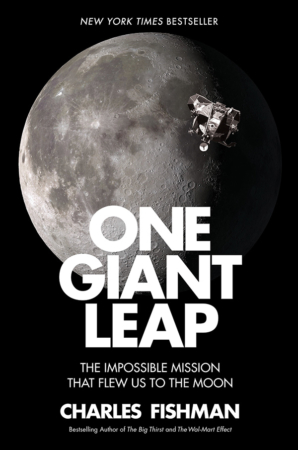Star light, star bright.
The first thing you see tonight is neither star nor planet. It’s technically a satellite, an orbiting astronomical sphere that seems to have a man’s face etched in its side. Once, though, it really did hold a man and in “One Giant Leap” by Charles Fishman, you’ll read about what went into the first moonwalk more than fifty years ago.
President John F. Kennedy was adamant.
Though he admitted to aides that he really didn’t care about space, he’d promised the American people that the U.S. would put a man on the moon before the decade was over. It rankled Kennedy that an American wasn’t first in space; that honor that went to Russian Yuri Gagarin in April 1961, and Kennedy wanted better. Some five weeks later, he made his pitch to the country, even though he knew it would be an uphill struggle: most Americans at that time didn’t see the need for space travel, and didn’t want to commit the money.
Nonetheless, NASA, which was still relatively new then, leaped into action. Gagarin had circled the planet, nobody really knew how to take the next step. Though World War II had left the U.S. with exceptional technology and knowledge to take us into the future, much of what was needed for space travel had yet to be invented. The Russians seemed to have a better space program in place but Kennedy pressed on.
And then he was assassinated.
Despite that JFK wasn’t interested in space itself, Lyndon Johnson certainly was and he “reaffirmed his determination to get the nation to the Moon by 1970.” When Richard Nixon was elected in 1968, he, too, was supportive of space travel. So were companies such as Playtex, General Motors, and IBM. So were hundreds of thousands of Americans who worked on behalf of the Apollo projects.
“Just five people watched Frank and Orville Wright make the first airplane flight,” says author Charles Fishman. But with five months to spare on Kennedy’s promise, “600 million people watched” on worldwide TV as two men planted a flag on the moon…
That’s the short story. There’s more to it inside “One Giant Leap,” but be warned: if you’re not very techy, parts of it may boggle your mind.
Really, though, there’s no other way that author Charles Fishman could have told this tale. Without a thorough accounting of the technology involved in winning the space race, the story is quite incomplete and it’s difficult to see the full picture of the work it took and the knowledge gained in the years between averral and Apollo. It helps that Fishman also puts this event into perspective by explaining what the world didn’t have and how strides in understanding and invention changed everything, as a whole.
But again, the tech: if it’s not your thing, work through it anyhow, for a story you need to know, as an American citizen. If you’re a STEM kind of person, though, you’ll find “One Giant Leap” to be five stars.
The Bookworm Sez: By Terri Shlichenmeyer
“One Giant Leap: The Impossible Mission That Flew us to the Moon” by Charles Fishman
c.2019, Simon & Schuster
$29.99 / $39.99 Canada
465 pages





Leave a Comment
Your email address will not be published. Required fields are marked with *